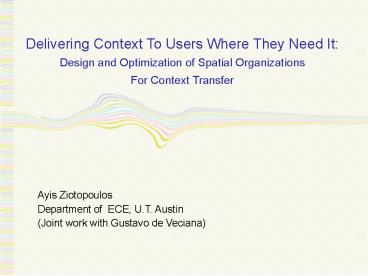Ayis Ziotopoulos PowerPoint PPT Presentation
1 / 24
Title: Ayis Ziotopoulos
1
Delivering Context To Users Where They Need
It Design and Optimization of Spatial
Organizations For Context Transfer
Ayis Ziotopoulos Department of ECE, U.T.
Austin (Joint work with Gustavo de
Veciana)?
2
Drowning in information, starving for knowledge
- Modern environments contain rich sources of
information, e.g. - Variety of sensors,
- location-based and spatial annotations (Yellow
arrow model), - RFID tags and readers
- Applications and services can benefit enormously
from exploiting useful information but can also
be hurt by processing increasing amounts of
irrelevant data
3
Context-Awareness as an Information Filter
- State-of-the-art mobile computing systems
increasingly employ some form of
context-awareness to filter out what is relevant - What is context? Information that can be used to
characterize the situation of an entity for
services, applications.
4
Location Matters!
- Our emphasis here will be on spatial context.
- What contextual information is relevant at a
given location? - On what spatial scales does it remain potentially
relevant ?
5
Related work
- Context acquisition/transfer
- Dey00, Schmidt02, Khedr04, Yamabe05, Yang06,
Wei07 - Geometrical modelling of spaces
- Brumitt00
- Stochastic Geometry
- Definitions, calculating the rate of boundary
crossingsStoyan87, Baccelli96, Baccelli99 - Context aggregation
- Cohen01, Kotz02, Ryu07
- Scalability Issues for Context
- Zimmer06
6
Austin Texas
7
University of Texas _at_ Austin Neighbourhood
8
My Office Floor..
9
The Central Problem This Talk ...
- How do we optimize distributed organizations to
store and transfer contextual information, so as
to - minimize data/energy transfer
- maximize context relevance
10
Stochastic Geometry Primer
11
Modelling Context Organization Using Aggregative
Tessellations
12
How does context content of a cell scale with
its area?
e.g. homogeneous distribution of services and
fine grained location information ???
c(Va) avg. context content per cell
e.g. homogeneous distribution of services ???
e.g. compression due to contextual redundancy ???
???a
13
Mobility Model
- Context transfers occur when mobiles cross cell
boundaries so intensity of context transfers
depends on how users move.
Fact Intensity of boundary crossings of a
homogeneous Poisson Voronoi tessellation with
intensity ? by typical user is
14
Transfer and Energy Cost Models
- Assumption 4
- The context transfer overhead to share d bits
with a user is linear wrt d, i.e., hKd where
h,K are constants. - Energy costs are assumed to be proportional to
the overhead.
15
Optimizing the Granularity Aggregation
16
Optimizing Aggregative Granularity Linear
context content scaling
- Theorem Under Assump. 4 and linear context
content scaling ????? - Aggregative organizations beat fine grain if
- Optimal rate for aggregative tessellation is
17
Optimizing Aggregative Granularity Generalized
Context Content Scaling
- Theorem Under Assump. 4, generalized context
content scaling - If ??????? aggregation always helps
- If ??????? aggregation only helps if
18
What's so special about ?????????
19
Hierarchical Organizations to Exploit Spatial
Redundancy ?????
- Hierarchical approach is to transfer
- the unique context of fine grain location from
fine grain cells - the shared context via aggregative cells
20
Hierarchical Organization
21
Hierarchical vs. Aggregative
- ? gt 1, 'super-linear'
- Aggregative organizations may help depending on
the scale of aggregation - Hierarchical organizations cannot help
- 1 gt ? gt 1/2, 'spatially correlated'
- Aggregative organizations may help depending on
the scale of aggregation - Hierarchical organizations eventually help
- Hierarchical organizations eventually beat
aggregative - ?????????'highly spatially correlated'
- Aggregative organizations always help
- Hierarchical organizations eventually help
- Aggregative organizations eventually beat
hierarchical
22
Surveillance
- How does a mobile know it moved to a new cell?
Two approaches - direct, shared surveillance infrastructure e.g.
RFID readers on doors - indirect, individual mobiles polling
- Theorem Direct surveillance is more
- efficient than indirect for services offered
- on a 'personalized' basis i.e. the context of
- a cell is proportional to the mobiles inside the
- cell.
23
What we are learning
- Organizations for transferring spatial context is
mostly about a relevance vs. overhead trade-off. - Aggregative organizations pay off in different
ways depending on content scaling - Hierarchical organizations do well when there is
redundancy and are less sensitive to specific
overheads.
24
Thank You!
- Questions?

